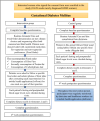Impact of a structured food sequence and mobile health monitoring on gestational diabetes outcomes: a clinical trial
- PMID: 40791233
- PMCID: PMC12336065
- DOI: 10.3389/fnut.2025.1562240
Impact of a structured food sequence and mobile health monitoring on gestational diabetes outcomes: a clinical trial
Abstract
Background: Gestational Diabetes Mellitus (GDM) is a common pregnancy complication that poses risks to both mother and baby. Dietary management is crucial in controlling blood glucose, and recent evidence suggests that the order in which food is consumed (food sequencing) can improve glycemic control. Mobile health (mHealth) tools also offer promising support for healthier eating habits and glucose monitoring. This study evaluates whether combining a structured food sequence with mHealth monitoring enhances outcomes in women with GDM.
Methods: Fifty-four pregnant women diagnosed with GDM were randomized into an intervention group (n = 27) and a control group (n = 27). The intervention group followed a structured food order-fiber first, then protein, and carbohydrates last-and tracked their intake using a mobile health application (JotForm). The control group received standard antenatal care without food sequencing. Fasting and postprandial glucose, lipid profiles, hemoglobin, and pregnancy outcomes were measured at baseline, the end of the third trimester, and 4 weeks postpartum. Data analysis included paired and independent t-tests or non-parametric equivalents, with chi-square tests for categorical variables. A p-value <0.05 was considered statistically significant.
Results: The intervention group showed significant reductions in 1-h and 2-h postprandial blood glucose levels (-8.41 mg/dL and -7.56 mg/dL respectively, both p < 0.001), decreased LDL cholesterol (-7.33 mg/dL, p < 0.001), increased HDL cholesterol (+6.15 mg/dL, p < 0.001), and improved hemoglobin levels. They also had more normal deliveries (13 vs. 10) and fewer cases of shoulder dystocia (2 vs. 5) compared to controls. Additionally, this group exhibited lower average birth weights, fewer NICU admissions, and reduced neonatal complications.
Conclusion: Combining a structured food sequencing approach with mHealth dietary monitoring improved maternal glycemic control and pregnancy outcomes in women with GDM. This strategy shows promise for supporting dietary adherence and managing GDM effectively, warranting further research to validate its broader application.
Clinical trial registration: https://ctri.nic.in/Clinicaltrials/main1.php?EncHid=93509.81482, identifier CTRI/2024/01/061220.
Keywords: blood glucose control; food order; gestational diabetes mellitus; mobile health application; pregnancy outcomes.
Copyright © 2025 Murugesan, Thiruselvam, Leela, Satheesan, Geetha, Ram and Kumar.
Conflict of interest statement
The authors declare that the research was conducted in the absence of any commercial or financial relationships that could be construed as a potential conflict of interest.
Figures
References
-
- Balleza-Alejandri LR, Peña-Durán E, Beltrán-Ramírez A, Reynoso-Roa AS, Sánchez-Abundis LD, García-Galindo JJ, et al. Decoding the gut microbiota–gestational diabetes link: insights from the last seven years. Microorganisms. (2024) 12:1070. doi: 10.3390/microorganisms12061070, PMID: - DOI - PMC - PubMed
LinkOut - more resources
Full Text Sources





